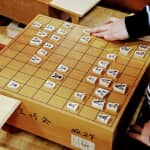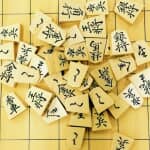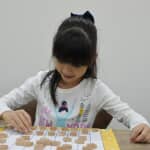Shogi 3 October 2017
Let’s play with a 5 × 5 Shogi Board
Regular Shogi board has 81 squares with nine horizontal rows (ranks) and nine vertical rows (files). I assume that this 9 × 9 board might be a bit difficult to use, especially for children who have just learned the way to move pieces and basic rules.
Probably, a 9 × 9 board could be too large for children to capture the whole picture on what is going on the board. Children might lose their focus, and as a result, they might make a piece-movement without enough consideration. Even though they have taken the trouble to master correct ways to move pieces, they might be overwhelmed.

5 × 5 Shogi board was designed to deal with this matter. Reducing squares from 9 × 9 to 5 × 5 provides much wider range of view and efficient clues to think how to move pieces, which is fundamental feature of Shogi.
You can say that this is like changing camera lenses. By replacing the lens, cameras can come into focus and capture more focused image than before. By using 5 × 5 Shogi board, children can get their focus back!
Mini-Shogi (a game with a small 5 × 5 Shogi board)
Let’s play Shogi with a small 5 × 5 board!

The following is a rule for Mini-Shogi. (Note, instructions described below is recommended by I-tsu-tsu. There are no official or proper rules at all. You may enjoy in many ways.)
- First, place Gyoku or Ou (King) at the center of the top rank.
- Select your favorite 4 pieces other than Gyoku or Ou and set them at the rest squares in your side. (Ability differences among selected pieces might affect the game. We would say, one Hisha (Rook) and one Kaku (Bishop) is a good combination. You can have upper hand over your opponent with strong pieces.)
- It’s time to start a game. The way to move each piece is the same as that of standard Shogi.
- Once you get into your opponent base, your piece will get a chance of promoting to become a stronger piece.
- By capturing opponent Gyoku, or moving your Gyoku or Ou to the end rank of your opponent base, you will win a game.
Mini version of Hasami Shogi, or pincher Shogi, and Mawari Shogi, or round Shogi.
Hasami Shogi and Mawari Shogi are easy to play on a 5 × 5 Shogi board, especially for young children who don’t know how to move pieces.
What is Hasami Shogi?
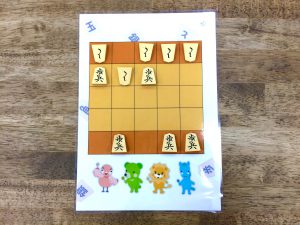
This is one type of Shogi games in which you pinch one of your opponent pieces with your two pieces to capture it. Only 10 pieces of Fu (Pawn) and both faces are used, 5 Fu and 5 To-Kin. If you use Fu, set 5 Fu at the bottom rank of your base and your opponent set 5 To-Kin at the bottom rank. All pieces can move along the rank or file for any number of squares. Once you pinch an opponent piece with your two pieces by putting them on the right and the left, or the front and the back of your opponent’s, you can take it. Or, you can take it by pushing it into the corner to deprive its way to move. Either player who has only one piece remained, loses the game.
What is Mawari Shogi?
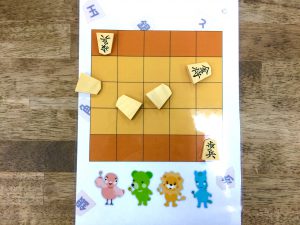
This is a game similar to Sugoroku game, or Snakes and Ladders. First, you put 4 pieces of Fu at each corner of the board. Four pieces of Kin are used as dices. Throw them and check the number of Kin facing up. Then move a piece forward the same number of squares. If your piece reaches the opposite corner, four squares ahead, it gets a chance to be promoted. The order of promotion is going to be Fu, Kyo, Kei, Gin, Kaku, Hisha, and Gyoku. A player whose piece becomes Gyoku first wins the game.
There are some rural specific rules: if one of four dices falls down form a board, you need to pass your turn once, or if any dice stands, you get 10 squares moves forward, and so on. You can enjoy this game more with your original rule.
The highlight of playing Hasami Shogi or Mawari Shogi with a 5 × 5 Shogi board is that you can finish a game in a short time. I think it is not easy for small children to maintain concentration. But with those Mini-Shogi, even small children could enjoy Shogi. The most important thing is not to let them get bored with Shogi.
I hope my recommendation for Mini-Shogi has appealed you a lot. Shifting from 9 × 9 to 5 × 5 sounds very simple, but it offers a great benefit on children who have just started Shogi to find fun out of it. Start with small steps!
